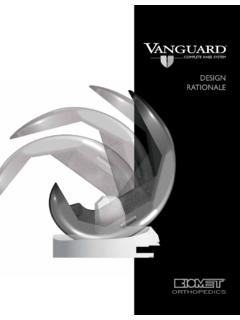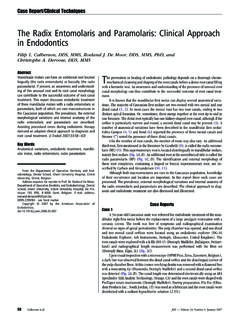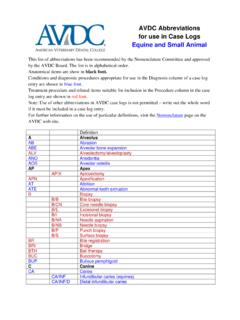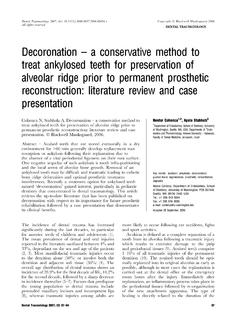Transcription of Zucchelli’s Modified Coronally Advanced Flap …
1 IOSR Journal of Dental and Medical Sciences (IOSR-JDMS) e-ISSN: 2279-0853, p-ISSN: 16, Issue 4 Ver. VI (April. 2017), PP 57-61 DOI: 57 | Page zucchelli s Modified Coronally Advanced flap technique for the Treatment of Multiple Recession Defects A Case Report Sneha Walkar1, Rakhewar2, Lisa Chacko3, Saihas Pawar4 Abstract: When multiple recession defects affecting adjacent teeth in aesthetic areas of the mouth are present , patient related considerations suggest the selection of the surgical techniques that allow all gingival defects to be simultaneously corrected with the soft tissue close to the defects present case report highlights the effectiveness of zucchelli s Modified Coronally Advanced flap with envelope technique for the treatment of multiple recession defects in patients with aesthetics demands.
2 Keywords: aesthetics; gingival recession; root coverage; surgery I. Introduction Gingival recession can be defined as the location of gingival margin apical to cemento-enamel junction .[1]Aesthetics is the primary indication for root coverage surgical procedures.[2] The international literature has thoroughly documented that gingival recession can be successfully treated by several surgical approaches,[3,4] provided that the biologic conditions for accomplishing root coverage are satisfied: no loss of height of interdental soft and hard tissues.
3 [5] In patients with an aesthetic request, the most important outcome is the percentage of complete root coverage, , the proportion of treated defects with the soft tissue margin at the level of or coronal to cemento-enamel junction (CEJ).[4,5,6,7] The Coronally Advanced flap is the first choice in patients with high aesthetic expections, when there is adequate keratinized tissue apical to the root exposure. With this approach, the soft tissue used to cover the root exposure is similar in color, texture, and thickness to that originally present at the buccal aspect of the tooth with the recession defect; thus, the aesthetic result is more satisfactory.
4 Multiple gingival recessions, affecting aesthetic areas of the mouth, were successfully treated with an envelope type of Coronally Advanced flap .[7] The presumed advantage of the envelope type of flap is the lack of vertical releasing incisions, which could damage the lateral blood supply to the flap and might result in unaesthetic visible white scars(keloids).[8] This case report describes zucchelli s Modified Coronally Advanced flap with envelope technique for the treatment of multiple recession defects in patients with aesthetics demands.
5 II. Case Report A 35 year old female patient reported to the department of periodontology, SMBT dental college and research center, with a chief complaint of poor esthetics due to receded gums in the upper left front region of the jaw with no relevant medical history. On clinical examination, Miller s class I recession was evident with 23 and 24 [Fig. 1A], with recession depth of 3mm and 2mm and width of 4mm and 3mm respectively [Fig. 1B,1C]. The periodontium was healthy with no signs of first visit after recording case history of the patient and routine investigations, thorough scaling and root planing was performed.
6 After 1 month root coverage with zucchelli scoronally Advanced flap was planned and informed consent was obtained from the patient. Pre-operative presentation zucchelli s Modified Coronally Advanced flap technique For The Treatment Of .. DOI: 58 | Page Fig 1B. depth-3mm, width-4mm Fig 1C. depth-2mm, width-3mm Surgical Procedure zucchelli s technique : Modification of Coronally Advanced flap for multiple teeth recession coverage.[9] Clinical features of zucchelli s technique are the absence of vertical releasing incisions, a variable thickness, combining areas of split and full thickness and the coronal repositioning of the flap .
7 Another characteristic feature is the submarginal oblique incisions in the interdental area. Incisions are given obliquely connecting the CEJ of one tooth to the gingival margin of the adjacent tooth.[10] [Fig. 2]. Disinfection of the surgical site was done with 2% procedure was carried out under local anesthesia (lignocaine HCL with 2% epinephrine 1: 200,000. A horizontal incision was made with a scalpel to design an envelope flap . The incision was extended to include one tooth on each side of the teeth to be treated in order to facilitate the planned coronal repositioning of the flap tissue over the exposed root surfaces.)
8 The horizontal incision of the envelope flap consisted of oblique submarginal incisions in the interdental areas, incisions which continued as intrasulcular incisions at the recession defects [Fig. 3]. The envelope was raised with a split-full-split approach in the coronal-apical direction: the oblique interdental incisions were carried out keeping the blade parallel to the long axis of the teeth in order to dissect in a split-thickness manner the surgical papilla. Gingival tissue apical to the exposure was raised in a full-thickness manner to provide that portion of the flap critical for root coverage with more thickness.
9 Finally the most apical portion of the flap was elevated in a split-thickness manner to facilitate the coronal displacement of the flap [Fig. 4]. The root surfaces were mechanically treated with the use of curettes. Exposed root surfaces in areas of anatomic bone dehiscence were not instrumented to avoid damaging any connective tissue fibers still inserted in the root cementum. The remaining tissue of the anatomic interdental papillae was de-epithelized to create connective tissue beds to which the surgical papilla were sutured [Fig.]
10 5]. While advancing the flap Coronally , surgical papillae were rotated towards the ends of the flap and were displaced on the prepared connective tissue beds of the anatomical papillae. The flap was secured in place with interrupted sutures [Fig. 6]. This ensured precise adaptation of the flap .The surgical site was then covered with periodontal dressing (coe-pak) zucchelli s Modified Coronally Advanced flap technique For The Treatment Of .. DOI: 59 | Page Fig 2.














